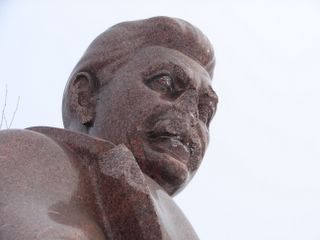Two Parks, Two Eras, One Russia
I’ve visited quite a few of the hotspots of Russian and soviet history in my time here. And like most of such tours, it has involved a good number of visits to gravesites; a cosmonaut in Chuvashia, Lenin on Red Square, tsars, princes, writers, and luminaries in both Moscow and St. Petersburg. I’m practically a certified guide for the necropolis at the Novodevichy Convent. But today’s excursion was slightly different; today was the first time I’d been to a cemetery for an ideology.
A huge park stretches along side the Moskva River in the middle of town. One side is the famous Gorky Park (or Park Kulturiy as the Muscovites have always called it) and the other side holds the New Tretyakov Gallery of 20th century art.
The New Tretyakov is surrounded by this beautiful park, and hosts a wonderful sculpture garden. Paths lead through pine trees and nearby church domes and bell towers poke over bushes and tree tops. The snow hushed things a bit, and brought the hum of two adjacent highways down to just a whisper.
In the back of this park is a separate area that costs 100 rubles to enter. There, many of the dismantled communist statues taken down around Moscow have found a last home. Labeled, strewn across the lawns, they are now historical oddities rather than living touchstones of political power. There are Lenin and Marx statues here in a variety of styles – even a rare statue of young Lenin while he still had hair and was years away from power in the USSR.
Here also is Felix Dzerzhinsky, the hated creator of the KGB, toppled by a jubilant crowd in Moscow as the Soviet Union fell. The plinth of his statue is still attacked with paint and slogans even here in this park.
There’s more obvious editorializing of an official sort over by the Stalin statue. His enormous pink granite likeness is surrounded by rough stone walls held together by iron bars and barbed wire. All around him, smaller sculptures of his victims stand vigil in anguished and tormented poses. It’s an eerie, but appropriate, way to remember a murderous tyrant.

You had it coming, comrade Stalin.

The park is also a good display of the unusual character of the Soviet Union. Heroic carvings of marauding tanks and brave soldiers clutching machine guns are juxtaposed with statues imploring peace; a man breaking a rocket in half, another beating his sword into a plowshare. Another is somewhat more confrontational. An Asian, a Slav, and an African all join hands in both metaphorical and literal steely defiance. “We Demand Peace” is the title.
A few feet away, children ride plastic down a slide and skitter along the ice. It’s an especially charming site among the frowning visages and firmly set jaws of granite soldiers and politicians.
I crossed the street over to Park Kulturiy for a more light-hearted stroll. Admission to the park is 50 rubles, with discounts for the usual benefactors: World War II veterans, students, invalids, etc. But for the first time I also saw a discount posted for emergency workers from the Chernobyl disaster.
Most of the miles of walkways and open spaces of the Park are frozen over and open for skating, which people do in great numbers – and at great speed with varying levels of skill. So I had to cut some of my walk short and head into less populated areas of the park.
It was a welcome relief. Most of the park is wired with loudspeakers that blare all sorts of music. Many leisure activities in Russia, I have learned, involve really loud music. At least the area with children’s rides was playing songs from Disney movies, but the main park was awash in Whitney Houston’s “I Will Always Love You” and The Eagles’ “Hotel California”, blasted from every lamp post.
So I saw it all today. The isolated, unmourned, stone corpses of the Soviet Union and the vibrant youthfulness of today’s Russia – skittering along a path it’s bound to slip and fall on at least a few times.





0 Comments:
Post a Comment
<< Home